Top 10 Materials for Countertops

Whether you’re redoing your current kitchen or creating your dream kitchen in a new construction home, you want a space that is timeless, stylish, and durable. A well-chosen countertop not only makes your kitchen more useful and easier to maintain, but can also serve as an important design element within the space.
When it comes to choosing a countertop for your home, there is a wide range of styles, materials, and colors to consider as well as durability, cost, and maintenance. Let’s explore the pros and cons of commonly used materials for countertops.
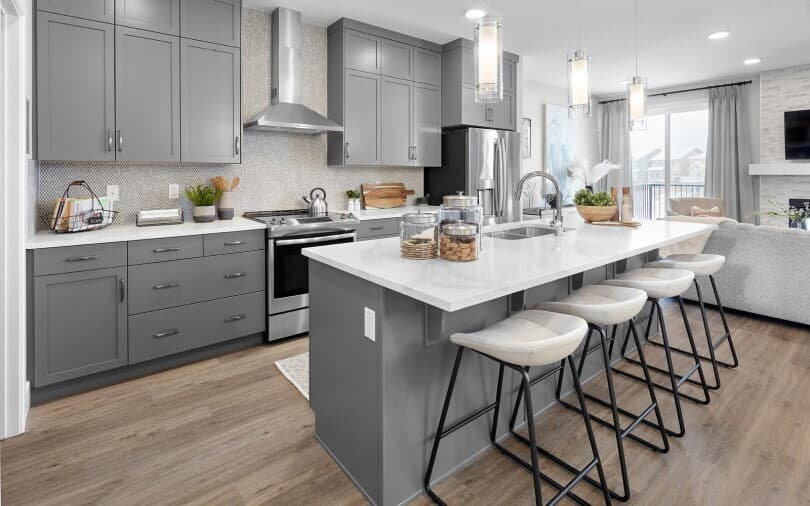
1. Quartz
Currently the most popular choice, quartz countertops are an engineered stone product composed of pulverized rock combined with resins for hardness and binding. Homeowners choose quartz countertops because of their many advantages.
Engineered quartz countertops are practically maintenance free as they are stain, acid, scratch, heat, and impact resistant and, thanks to their non-porous surface, don’t need to be sealed like natural stone countertops.
Quartz countertops come in a wide range of colors and some are convincing copies of natural stone including marble and granite.
Pros of Quartz Countertops
- Easy to maintain; no sealing required; clean with soap and water
- Extremely durable
- High variety of elegant, sleek, and modern designs
- Highly sought after which creates high resale value in a home
- Accessible price point
- Versatile; can be used in other spaces including bathrooms, fireplaces, and more
Cons of Quartz Countertops
- Other materials available at a cheaper price point
- Impossible to perfectly match the unique appearance of natural stone
- Extremely heavy material; professional installation preferable
- Seams may be noticeable, especially in lighter colors
- Prone to fading and discoloration in direct sunlight
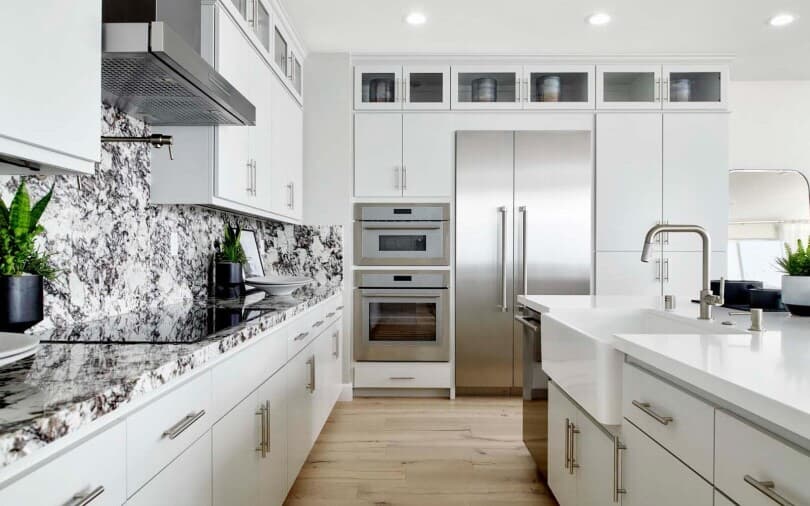
2. Granite
Before quartz snuck in the lead, granite was considered the countertop material of choice for many years. Even the most modest kitchen felt elevated into a luxurious space with the use of granite countertops.
Granite is a natural stone material quarried from the earth and fabricated to a specified size. It’s very strong and durable, and is available in thousands of different colors. No two pieces of granite are exactly alike, making each countertop entirely unique.
While granite is heat and stain resistant, it’s not impervious to damage. It requires resealing to avoid stains and edges and corners can chip if nicked in just the right spot. Granite patterns often command attention so you’ll want to keep other elements in the space simple in design.
Pros of Granite Countertops
- Very strong and durable
- Each slab is unique making your countertop one-of-a-kind
- Considered a premium material which increases your resale value
- No-seam countertops are usually possible
- Accessible price point
Cons of Granite Countertops
- Extremely heavy with labor-intensive installation
- Requires regular sealing to avoid stains
- Can chip at the edges or corners
- Natural variations in stone may mean your slab may not look like the sample
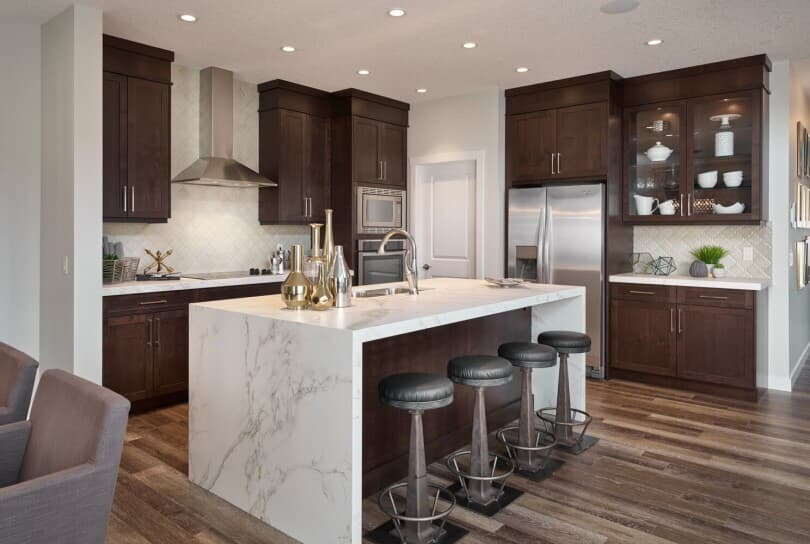
3. Marble
Marble is one of the most classic and beautiful natural stones to use for countertops. Many designers feel that nothing rivals the natural beauty of the muted tones, vein patterns, and different varieties. The delicate detailing combined with sophisticated hues result in a timeless appeal.
Marble is relatively soft and porous so it’s not as heat and stain resistant as granite and can show knife scars after repeated cutting. It also requires annual sealing and daily care by cleaning with soap and water. With proper care, however, marble countertops can wear beautifully for decades to come.
Marble comes in two finishes: honed and polished. Honed marble is porous and has a matte appearance, where polished marble has a more protective surface with a shiny sheen.
Pros of Marble Countertops
- Exceptionally beautiful stone with unique veining
- Each slab has slightly different veining making each piece one-of-a-kind
- Classic appearance that stands the test of time
- High end material which increases resale value
Cons of Marble Countertops
- Higher price point
- High maintenance material – can be scratched and stained; needs annual resealing and daily cleaning
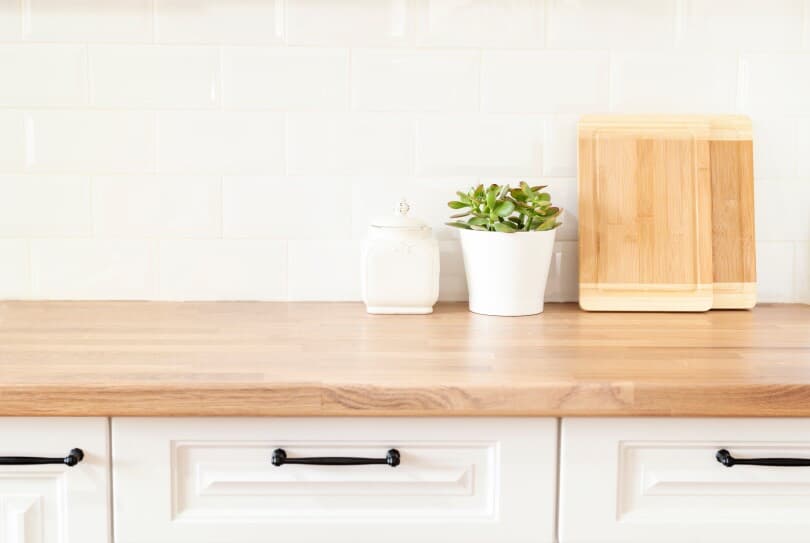
4. Wood or Butcher Block
Wood countertops are a great choice for both a work surface and as a warm design element. A butcher block style countertop infuses a warm, farmhouse-style look into any home with straight cuts of wood that are glued together into thick slabs to provide a sturdy and stable work surface.
Wood countertops are available in a wide range of colors and finishes. Hardwoods such as maple and oak are most commonly used, but many other species including birch, cherry, and walnut can be used to create various looks and feels for your kitchen.
Wood countertops need to be finished super well – lots of water or hot pans and wood tops don’t mix. Added bonus: when properly sealed, wood countertops are ideal for food prep because they do not harbor any unwanted bacteria on the surface.
Pros of Wood Countertops
- Relatively easy to clean
- Easy to install
- Attainable price point
- Can be sanded and resealed as needed
- Organic element offers a warm, rustic look
- Green and eco-friendly material compared to other options
Cons of Wood Countertops
- Surfaces can be scratched and cut by knives
- Can be damaged by water and stains over time
- Not resistant to heat
- Requires proper maintenance to ensure bacteria doesn’t become a problem
- Must be oiled and sealed frequently to prevent stains and cracking
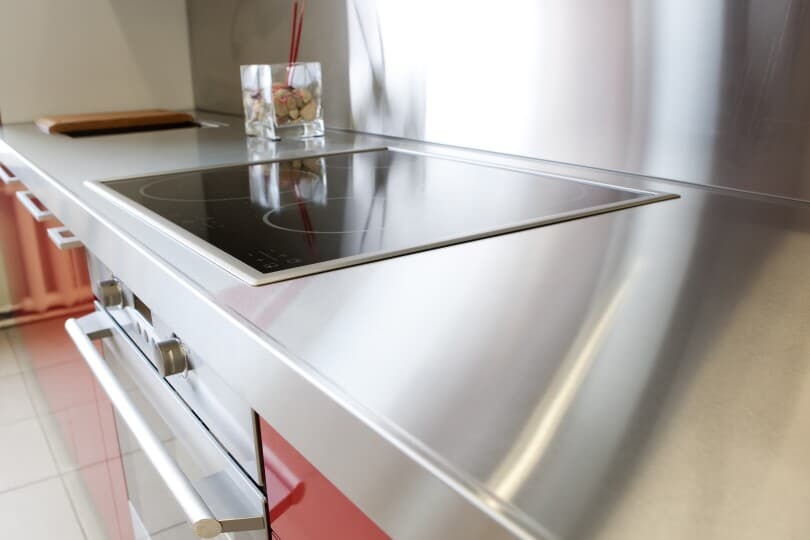
5. Stainless Steel
For an ultra-contemporary and industrial look for your kitchen, stainless steel is a good choice. Durable, heat and stain resistant, hygienic and impervious to water, stainless steels brings the sleek look of a restaurant kitchen into your home.
Stainless steel countertops are constructed to the exact specifications of your space which means you’ll have a seamless countertop. It brings a sharp, clean look to the kitchen and forms a striking contrast when paired alongside natural materials such as wood.
While durable, this material can scratch (though some feel this enhances the industrial aesthetic) and comes at a prohibitive price point for most people so typically only found in upper-end homes where the look of a commercial kitchen is desired.
Pros of Stainless Steel Countertops
- Impervious to heat damage
- Excellent for modern-style kitchens
- Easy to clean
- Considered a premium product which increases resale value
- Germ-resistant and very sanitary
Cons of Stainless Steel Countertops
- Expensive to fabricate
- Can be easily scratched
- Can create a cold look and feel in the kitchen
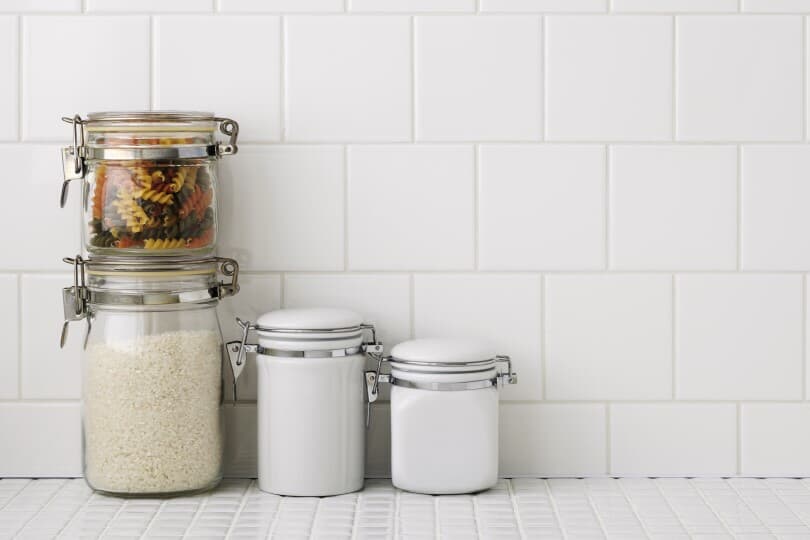
6. Ceramic Tile
Ceramic tile was once the go-to material to kitchen countertops. There’s a wide range of looks and colors making them a beautiful and versatile material. They’re durable, easy to clean, and considerably more affordable than natural stone or quartz. If you’re willing to take on a DIY project, you can take on the installation yourself and save even more money.
Ceramic tile countertops are made from individual tiles adhered over a cement-board core using thin-set mortar adhesive. Newer innovations with tile help minimize the number of grout seams resulting in easier upkeep. If a tile cracks, it’s easily replaced.
Pros of Ceramic Tile Countertops
- Easy to clean
- Affordable
- DIY project you can tackle
- Immune to heat damage
- Enormous range of styles and colors
Cons of Ceramic Tile Countertops
- Grout seams can stain and are difficult to clean; need to be sealed often
- Does not carry the same prestige as other materials and may look dated
- May crack under impact
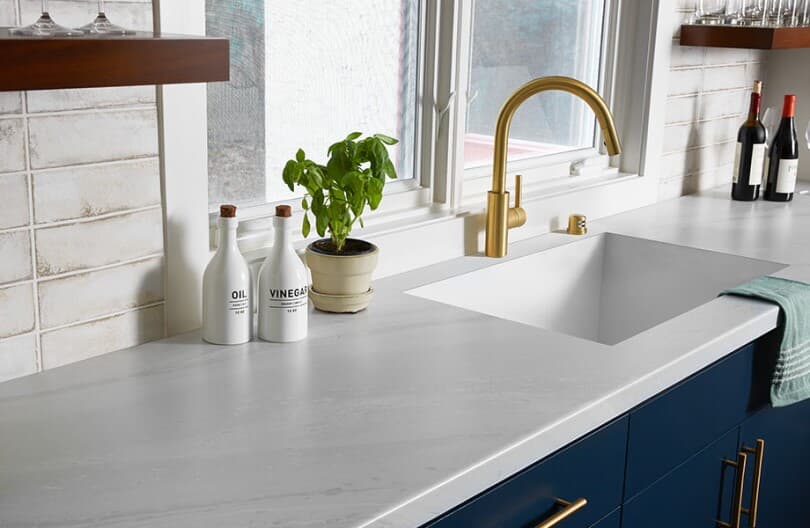
7. Laminate
Plastic laminate, also known by its trade name Formica, is a surprisingly durable countertop material that can survive many years in the toughest kitchens. It comes in hundreds of colors and patterns so you’re sure to find an option you love.
Laminate countertops are a paper-plastic product that bonds several layers of laminate sheets to a particleboard core. It’s lightweight and easy to install, maintain, and clean.
Homebuyers are torn on the appeal of laminate. Many view it as an inferior product with low resale value, while others find it perfect for a retro remodel, particularly midcentury modern kitchens.
Pros of Laminate Countertops
- Very easy to maintain
- Thousands of options available
- DIY installation is relatively easy
- Inexpensive
Cons of Laminate Countertops
- Seams are always visible
- May be viewed as inferior; low resale value
- Can be scratched, chipped, or peel up; almost impossible to repair
- Susceptible to heat damage
- Shorter lifespan
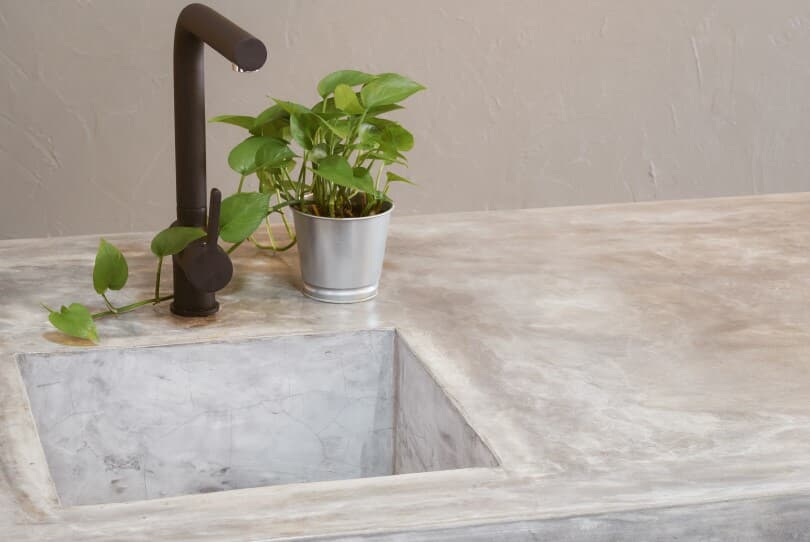
8. Concrete
Concrete countertops have become trendier and more stylish recently. They closely resemble natural stone and the end result is a truly custom countertop.
Due to their heavy weight, concrete countertops are usually cast in forms right in your kitchen making them a great solution if you have unusual shapes. These are not the same kind of concrete slabs used in sidewalks, but are highly polished slabs that may even be textured or acid-stained to produce colors.
Concrete countertops are scratch and heat resistant but may be susceptible to cracking.
Pros of Concrete Countertops
- Highly durable
- Can be color-tinted to create the perfect hue
- Heat and scratch resistant
- Custom, one-of-a-kind look
- Can fit any size or shape
- Long lifespan
Cons of Concrete Countertops
- Requires regular waxing and sealing
- Not resistant to stains
- Cracking may occur over time
- Can be costly due to custom work
- Not a DIY project
- Doesn’t have mass appeal; may be deemed too industrial
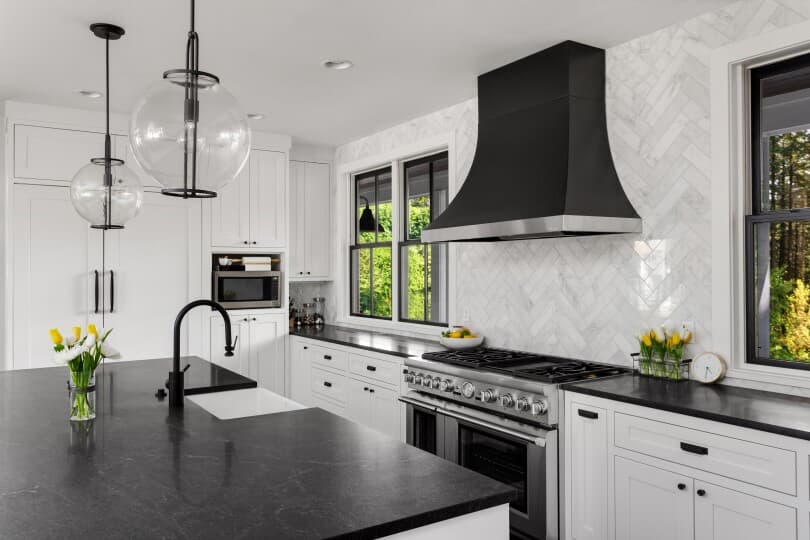
9. Soapstone
In many ways, soapstone is the hardest working countertop in the bunch. It’s dense and nonporous, allowing it to hold its own against liquid, stains, and acidic materials. It’s also heat resistant, so you can place a dish fresh out of the oven onto it with zero worry.
Even better? While soapstone is soft and susceptible to scratching (which some think adds character), the marks can be easily buffed out with sandpaper. Soapstone is often seen in historic homes but has had a recent resurgence as an alternative to granite.
Another quarried stone, soapstone has a warm, milky appearance that allows it to complement other design features without overwhelming them. Soapstone comes in rich, deep grays as well as varying whites making it the perfect addition to virtually any kitchen décor.
Pros of Soapstone Countertops
- Deep, rich color that fits in almost every kitchen
- Somewhat stain resistant
- Fairly impervious to heat
- Damage can be sanded out
- Not a highly used product so it creates a unique conversation piece
Cons of Soapstone Countertops
- Must be treated with mineral oil
- Surface can be gouged, scratched or dented
- Can be rather expensive
- Limited selection of colors
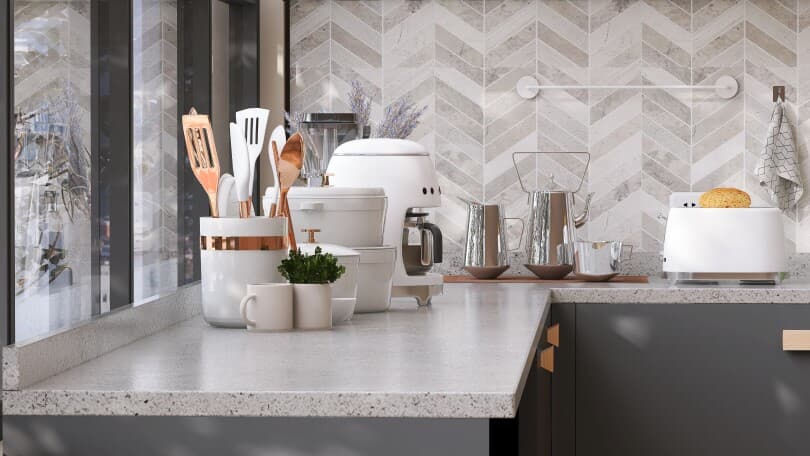
10. Solid Surface
Solid surface, commonly known by brand names such as Corian or Avonite, is a synthetic material originally created as an alternative to natural stone. It’s made mostly of blends of synthetic acrylic and polyester materials, sometimes with a small amount of natural stone dust blended in.
Solid surface countertops offer low maintenance and a wide variety of color and pattern choices. They’re highly stain and scratch resistant and completely renewable and repairable. Scratches and burns can be sanded out; deep gouges can be filled. Slabs can be fused together to create undetectable seams making them a great solution for long countertops.
Although solid surface lacks the depth and detail of natural stone, they can closely mimic the appearance of granite, marble or other natural materials at a more affordable price.
Pros of Solid Surface Countertops
- Stain resistant
- Seams are virtually invisible
- Damage can easily be repaired
- Wide range of colors and patterns; good imitations of natural stone available
- More affordable compared to natural stone or engineered quartz
Cons of Solid Surface Countertops
- Not as highly regarded amongst homebuyers
- Not heat resistant; prone to scorching
- Scratches and cuts easily
Discover More Home Design Trends
Looking for more home design trends? Be sure to follow the Brookfield Residential blog for more design advice, homebuying insights, mortgage tips, and more. Explore where we build and connect with our sales team when you’re ready to learn more. We’ll be expecting you!
